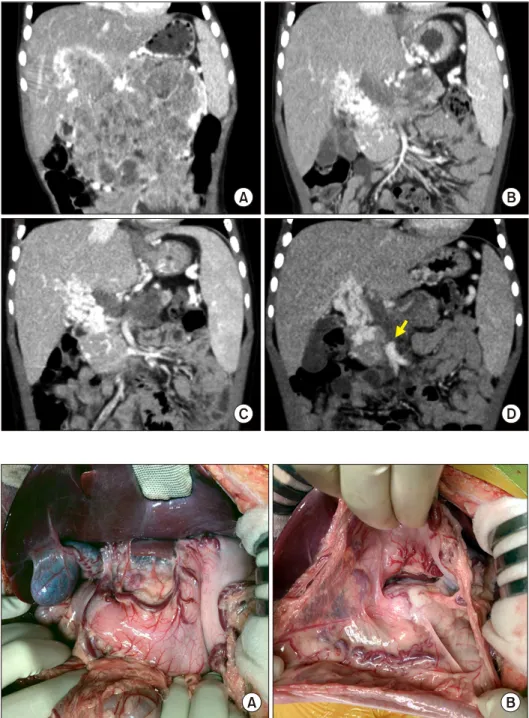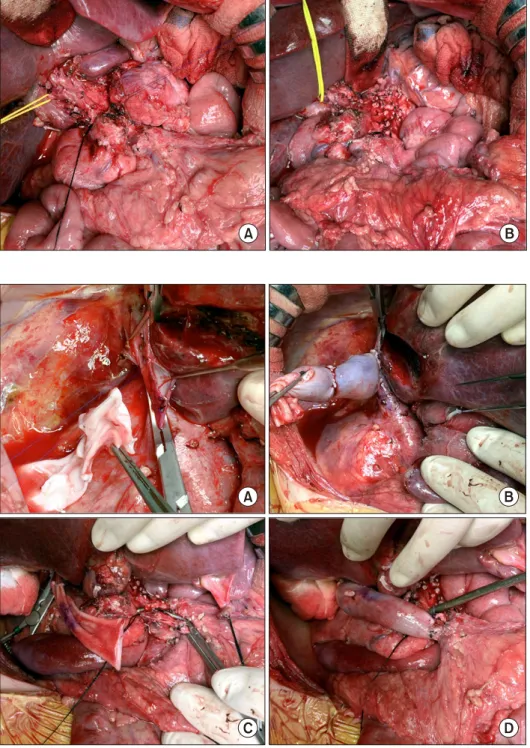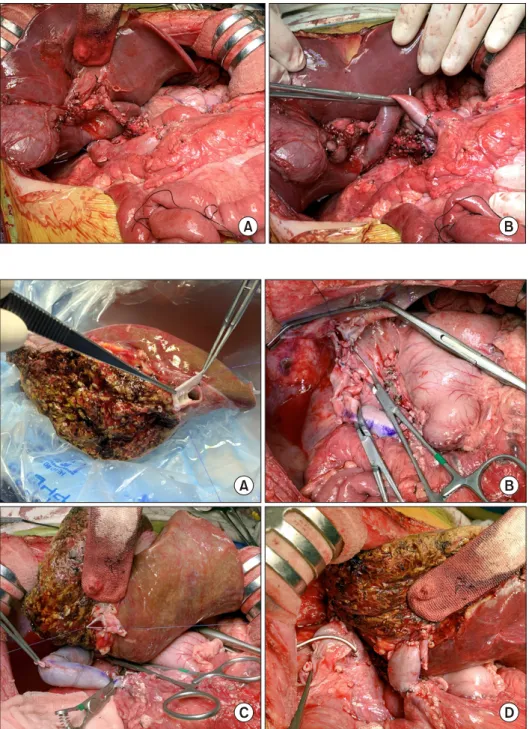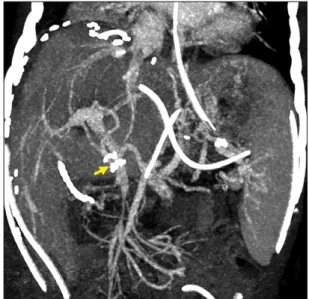Living donor liver transplantation with total pancreatectomy and portal vein homograft replacement in a pediatric patient with
advanced pancreatoblastoma
Jung-Man Namgoong1, Shin Hwang2, Seak Hee Oh3, Kyung Mo Kim3, Gil-Chun Park2, Chul-Soo Ahn2, Hyunhee Kwon1, Yu Jeong Cho1, and Yong Jae Kwon1
1Division of Pediatric Surgery, Department of Surgery, Asan Medical Center, University of Ulsan College of Medicine, 2Division of Hepatobiliary Surgery and Liver Transplantation, Department of Surgery,
Asan Medical Center, University of Ulsan College of Medicine, 3Department of Pediatrics, Asan Medical Center, University of Ulsan College of Medicine, Seoul, Korea
Pancreatoblastoma is a malignant exocrine pancreatic tumor that is usually present in childhood. We herein present one case of pediatric living donor liver transplantation (LDLT) combined with spleen-preserving regional total pan- createctomy and portal vein homograft interposition in a 4-year-old boy with advanced pancreatoblastoma invading the portal and superior mesenteric veins. The size of the pancreatoblastoma was gradually reduced along systemic chemotherapy, thus we decided to perform surgery to remove it completely. A cold-stored fresh iliac vein homograft was prepared. Initially, a spleen-preserving distal pancreatectomy was performed. Thereafter, a completion regional total pancreatectomy was performed under superior mesenteric vein-vena cava bypass. A left liver graft from his mother was implanted according to the standardized procedures with portal vein interposition. This patient recovered unevent- fully and is currently undergoing scheduled adjuvant chemotherapy. To our knowledge, this is the world-second case of pediatric LDLT for advanced pancreatoblastoma. Availability of fresh vein homografts is helpful to expand the in- dication of pediatric LDLT. (Ann Hepatobiliary Pancreat Surg 2020;24:78-84)
Key Words: Homograft; Pancreatectomy; Pediatric transplantation; Pancreatoblastoma
Received: January 30, 2020; Revised: February 3, 2020; Accepted: February 7, 2020 Corresponding author: Shin Hwang
Department of Surgery, Asan Medical Center, University of Ulsan College of Medicine, 88 Olympic-ro 43-gil, Songpa-gu, Seoul 05505, Korea Tel: +82-2-3010-3930, Fax: +82-2-3010-6701, E-mail: shwang@amc.seoul.kr
Copyright Ⓒ 2020 by The Korean Association of Hepato-Biliary-Pancreatic Surgery
This is an Open Access article distributed under the terms of the Creative Commons Attribution Non-Commercial License (http://creativecommons.org/
licenses/by-nc/4.0) which permits unrestricted non-commercial use, distribution, and reproduction in any medium, provided the original work is properly cited.
Annals of Hepato-Biliary-Pancreatic Surgery ∙ pISSN: 2508-5778ㆍeISSN: 2508-5859
INTRODUCTION
Pancreatoblastoma is a malignant exocrine pancreatic tumor that is usually present in childhood.1-3 Its incidence of occurrence is very rare, but it is the most common pan- creatic tumor in children. Pancreatoblastoma is an ag- gressive tumor and often unresectable at diagnosis. In or- der to achieve size reduction before surgical resection, ne- oadjuvant chemotherapy is usually necessary.1-3 Complete surgical resection is necessary to improve survival out- comes, but this is difficult in patients with extensive ex- tra-pancreatic tumor extension or distant metastasis. Since there is only a few case reports on metastatic pancreato- blastoma in literature, standard treatments have not been established yet.1-4 There was only one case report on liver transplantation for metastatic pancreatoblastoma in litera-
ture.5
We herein report one case of pediatric living donor liv- er transplantation (LDLT) combined with spleen-preserv- ing regional total pancreatectomy and portal vein homo- graft interposition in a 4-year-old boy with advanced pancreatoblastoma.
CASE
The patient was a 4-year-old boy, weighing 16 kgs and suffering from huge biopsy-proven pancreatoblastoma, which was diagnosed 9 months before (Fig. 1A). This pancreatoblastoma was partially responsive to systemic chemotherapy (Fig. 1B, C). The residual tumor occupied the pancreas and infiltrated along the main portal vein (PV) with cavernous transformation (Fig. 1D), by which
Fig. 1. Pretransplant computed tomography findings. The size of pancreatoblastoma was gradu- ally reduced according to the neoadjuvant chemotherapy, sh- owing serial size changes as fol- lows: at diagnosis (A), five mon- ths before transplantation, (B) one month before transplanta- tion, and (C) one week before transplantation (D). An arrow indicates the proximal end of the superior mesenteric vein.
Fig. 2. Intraoperative photogra- phs of the recipient’s abdomen.
No peritoneal seeding was iden- tified at the mesenteric side (A) and around the pancreas (B).
an iliac vein homograft was necessary to replace the PV and superior mesenteric vein (SMV), we had to wait until a cold-stored fresh iliac vein homograft was available.
After waiting for three weeks, we obtained an iliac vein homograft that was recovered from a deceased organ
spleen-preserving distal pancreatectomy with extensive dissection of the celiac axis. Thereafter, the duodenum, pancreas head and uncinated process were meticulously dissected to isolate the SMV (Fig. 3). Since the PV was completely occluded and PV collaterals should be trans-
Fig. 3. Intraoperative photogra- phs of spleen-preserving distal pancreatectomy. The pancreas body was transected to facili- tate pancreatic resection (A).
The celiac axis area was comple- tely dissected (B).
Fig. 4. Intraoperative photogra- phs of the superior mesenteric vein-vena cava bypass using a cold-stored fresh iliac vein homograft. The vein graft is ana- stomosed to the retrohepatic in- ferior vena cava (A and B). The vein conduit was anastomosed to the superior mesenteric vein as an end-to-side fashion (C and D).
ected to perform regional total pancreatectomy, the pre- pared iliac vein homograft was anastomosed to the retro- hepatic inferior vena cava as an end-to-side fashion (Fig.
4A, B), which would be used for SMV-vena cava bypass.
The main PV and proximal portion of the SMV was com- pletely occluded, thus the uppermost portion of the intact SMV was incised and the iliac vein conduit was anasto- mosed as an end-to-side fashion for SMV-caval bypass (Fig. 4C, D). The transected SMV stump margin was sent for frozen-section biopsy, which was reported to be tu-
mor-negative. Under the SMV-caval bypass, regional total pancreatectomy was meticulously performed with preser- vation of the common hepatic artery. Repeated fro- zen-section biopsies were performed during peripancreatic dissection to ensure that no tumor mass was left behind.
Eight hours were taken for completion of the spleen-pre- serving regional total pancreatectomy and SMV-caval by- pass (Fig. 5).
Thereafter, a 415-weighing extended left liver graft was harvested. The graft hepatic vein orifices were unified
Fig. 5. Intraoperative photogra- phs of spleen-preserving reg- ional total pancreatectomy. The common hepatic artery was pre- served with extensive lymph node dissection (A). Superior mesenteric vein-caval bypass was maintained during pancreatecto- my (B).
Fig. 6. Intraoperative photogra- phs of the left liver graft im- plantation. The graft hepatic vein orifices were unified with an iliac vein patch (A). The recipi- ent’s native liver was removed with clamping of the superior mesenteric vein-caval bypass (B). The venous bypass was cl- amped (C). The iliac vein con- duit was anastomosed to the gra- ft portal vein (D).
vein according to the standardized techniques (Fig. 6C, D). Reconstruction of the single left hepatic artery and Roux-en-Y hepaticojejunostomy were sequentially per- formed (Fig. 7). The pathology report presented that there was residual viable pancreatoblastoma at the pancreas tis-
atic enzyme supplement.
DISCUSSION
Pancreatoblastoma is a rare primary malignant tumor
Fig. 7. Intraoperative photographs of the recipient’s abdomen after graft implantation. The extent of dissection was visualized. An arrow indicates the interposed iliac vein homograft.
Fig. 8. Gross photographs of the resected specimens including the liver, pancreas and duodenum.
Fig. 9. Posttransplant computed tomography finding showing streamlined reconstruction figures of the graft hepatic and portal veins taken one week after transplantation. An arrow indicates the interposed iliac vein homograft.
that occurs during childhood with a peak incidence around 5 years of age. Its annual incidence was 0.004 new cases per 100,000 population, but it is the most common pan- creatic tumor in children.1-5 Complete surgical resection is necessary to improve the survival outcomes. The over- all 5‐year patient survival rates were reported to be 30-50%.4 However, the prognosis of patients with ad- vanced pancreatoblastoma with or without metastasis was poor. About 30% of patients present with metastasis and few of them become long‐term survivors. One study with 17 cases with metastatic pancreatoblastoma reported 25%
of 5‐year survival rate.4
The treatment outcomes of the pancreatoblastoma did not correlate with the tumor site and size, but was strong- ly influenced by the feasibility of complete resection of the tumor.4 To achieve complete tumor removal in ad- vanced pancreatoblastoma with or without metastasis, LT can be combined with pancreatectomy. There is only one case of LT for advanced pancreatoblastoma in literature.5 The 4-year-old boy had pancreatoblastoma with liver metastasis. After downsizing with neoadjuvant chemo- therapy, the patient underwent staged operations. The first operation was a subtotal pancreatectomy to remove the pancreatic mass. Two days later, the resection margins were pathologically proven to be tumor-negative and vas- cular structures were not involved in the pathology report.
Thereafter, LDLT operation was performed with a left lat- eral section graft from his aunt. He underwent post- operative adjuvant chemotherapy and is alive and healthy, and has now been tumor‐free for 7 years with no tumor relapse.5
To our knowledge, our case is the second case of LT for advanced pancreatoblastoma. Unlike the above men- tioned world-first case,5 the primary reason of performing LT in our patient was because we could not save the liver due to hilar invasion with complete PV occlusion and col- lateral formation. After extensive discussion, we finally decided to perform LDLT and regional total pan-
atic malignancies,6 we progressed the initial distal pan- createctomy very slowly because most of the pancreatic and peripancreatic tissues were heavily adhered and ves- sels were fragile. If the regional lymph nodes and neural plexus at the celiac axis had been tumor-positive, we would have cancelled the LDLT operation because such R1/R2 resection would definitely increase the risk of post-transplant tumor recurrence.7,8 After confirming that the initial spleen-preserving distal pancreatectomy was microscopically curative (R0 resection), we started addi- tional procedures for regional total pancreatectomy and LDLT.
In our case, we used the SMV-caval bypass to securely perform pancreatoduodenectomy. Since the main PV was completely occluded and abundant collaterals were form- ed, secure peripancreatic dissection was difficult due to fragile bleeding. The SMV-caval bypass was effective in preventing dissection-associated bleeding, which enabled us to perform meticulous removal of the tumor. If a lengthy iliac vein homograft was not available, such by- pass would have not been possible because any prosthetic vascular graft cannot be anastomosed to the thin-walled SMV stump and such grafts cannot be used for PV inter- position in a pediatric patient.
After deciding to perform LDLT with SMV-caval by- pass in this case, we had to wait three weeks to obtain a fresh cold-stored iliac vein homograft, which was recov- ered from a deceased organ donor. The homograft was re- trieved after obtaining a written consent on tissue dona- tion and registered it to the tissue bank at our institution.
At this time, we urgently scheduled the LDLT operation just after confirmation of negative bacteria culture finding.
To use the iliac vein homograft in a fresh state, it can be stored in 4℃ within 7 days instead of cryopreservation.
In pediatric recipients, various vein homografts, such as iliac vein, inferior vena cava and other large-sized veins, can be used depending on the body size of the recipient and availability of vessel graft. We suggest that the use of cryopreserved veins should be avoided if possible for
Jung-Man Namgoong: https://orcid.org/0000-0002-9237- 7440
Shin Hwang: https://orcid.org/0000-0002-9045-2531 Seak Hee Oh: https://orcid.org/0000-0002-9672-8877 Kyung Mo Kim: https://orcid.org/0000-0001-7896-6751 Gil-Chun Park: https://orcid.org/0000-0003-1631-3258 Chul-Soo Ahn: https://orcid.org/0000-0002-3844-3646 Hyunhee Kwon: https://orcid.org/0000-0001-6647-9155 Yu Jeong Cho: https://orcid.org/0000-0001-6823-2746 Yong Jae Kwon: https://orcid.org/0000-0001-9490-1229
AUTHOR CONTRIBUTIONS
Conceptualization: SH, JMN.
Data curation: SHO, KMK.
Formal analysis: GCP, CSA, HK, YJC, YJK.
Funding acquisition: Not applicable.
Methodology: JMN, SH.
Project administration: SH.
Visualization: JMN, SH.
Writing - original draft: JMN, SH.
Writing - review & editing: SH.
REFERENCES
1. Dhebri AR, Connor S, Campbell F, Ghaneh P, Sutton R, Neo- ptolemos JP. Diagnosis, treatment and outcome of pancreato- blastoma. Pancreatology 2004;4:441-451; discussion 452-453.
2. Défachelles AS, Martin De Lassalle E, Boutard P, Nelken B, Schneider P, Patte C. Pancreatoblastoma in childhood: clinical course and therapeutic management of seven patients. Med Ped- iatr Oncol 2001;37:47-52.
3. Glick RD, Pashankar FD, Pappo A, Laquaglia MP. Management of pancreatoblastoma in children and young adults. J Pediatr Hematol Oncol 2012;34 Suppl 2:S47-S50.
4. Bien E, Godzinski J, Dall'igna P, Defachelles AS, Stachowicz- Stencel T, Orbach D, et al. Pancreatoblastoma: a report from the European cooperative study group for paediatric rare tumours (EXPeRT). Eur J Cancer 2011;47:2347-2352.
5. Ghaffarian AA, Book L, Meyers RL. Liver transplant for meta- static pancreatoblastoma: 7-year event-free survival after chemo- therapy, pancreatectomy, complete hepatectomy, and liver trans- plant. Pediatr Transplant 2018. doi: 10.1111/petr.13098.
6. Cho HD, Hwang S, Lee YJ, Park KM, Kim KH, Kim JC, et al. Changes in the types of liver diseases requiring hepatic re- section: a single-institution experience of 9016 cases over a 10-year period. Korean J Hepatobiliary Pancreat Surg 2016;20:
49-52.
7. Ibuka S, Uehara S, Ueno T, Oue T, Miyamura T, Hashii Y, et al. Complete resection of pancreatoblastoma with portal vein ob- struction after high-dose chemotherapy: a case report. J Pediatr Hematol Oncol 2017;39:e275-e278.
8. Lindholm EB, Alkattan AK, Abramson SJ, Price AP, Heaton TE, Balachandran VP, et al. Pancreaticoduodenectomy for pediatric and adolescent pancreatic malignancy: a single-center retro- spective analysis. J Pediatr Surg 2017;52:299-303.
9. Sugawara Y, Makuuchi M, Tamura S, Matsui Y, Kaneko J, Hasegawa K, et al. Portal vein reconstruction in adult living do- nor liver transplantation using cryopreserved vein grafts. Liver Transpl 2006;12:1233-1236.



